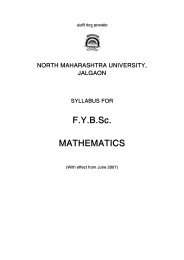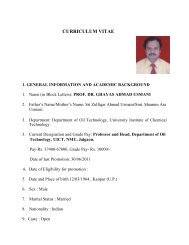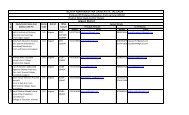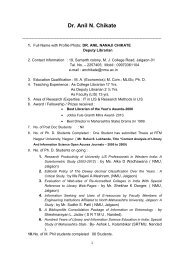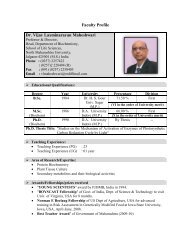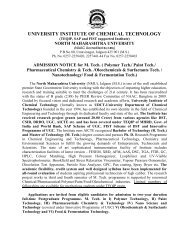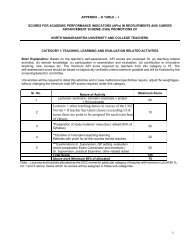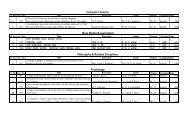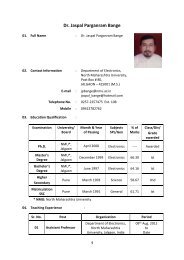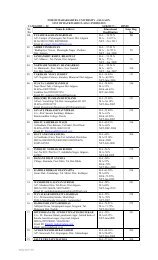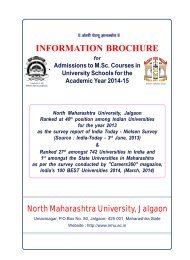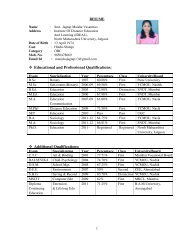Question bank for F.Y. B.Sc. Botany - North Maharashtra University
Question bank for F.Y. B.Sc. Botany - North Maharashtra University
Question bank for F.Y. B.Sc. Botany - North Maharashtra University
You also want an ePaper? Increase the reach of your titles
YUMPU automatically turns print PDFs into web optimized ePapers that Google loves.
<strong>Question</strong> <strong>bank</strong> <strong>for</strong> F.Y. B.<strong>Sc</strong>. <strong>Botany</strong>Paper-I Diversity Of Lower And Higher CryptogamsPaper-II Economic And Applied <strong>Botany</strong>-Prepared by-Chairperson, Members Of Board of Studies and Experiencedteachers in <strong>Botany</strong> Of<strong>North</strong> <strong>Maharashtra</strong> <strong>University</strong>,Jalgaon.-Approved by-Dean, <strong>Sc</strong>ience faculty,<strong>North</strong> <strong>Maharashtra</strong> <strong>University</strong>,Jalgaon.
<strong>Botany</strong> paper IDiversity of Lower and Higher cryptogamsTerm-IChapter: 1 Diversity of Lower cryptogams2 Marks <strong>Question</strong>s:1. Define diversity? Explain diversity in algae2.What is diversity? Explain diversity in fungi3.The study of algae is known as --------a) Mycologyb) Phycologyc) Taxonomyd) Physiology4. The branch which deals with study of fungi is known as--------a) Physiologyb) Ecologyc) Mycologyd) Phycology5.Thalloid and non flowering plants are known as -------a)Angiospermb)Thallophytac)Gymnospermd) DicotyledonsChapter: 2 Algae2 Marks <strong>Question</strong>s:1. What is epiphytic algae2. What is symbiotic algae3. The reserve food material in algae is --------a) celluloseb) starchc) proteind) glycogen4.The cell wall in algae is made up of--------a) Chitinb) cellulose
c) pectind) glycogen5. Fusion between gametes of equal sizes is called ------a) Isogamyb) Anisogamyc) Oogamyd) Dichotogamy6. Fusion between gametes of unequal sizes is called ------a) Dichotogamyb) Anisogamyc) Oogamyd) Isogamy7. An alga growing on aquatic animal is called--------a) Epizoicb) Endozoicc) Epiphyticd) Terrestrial8. The algae growing in seawater is known as -------a) Freshwater algaeb) Terrestrial algaec) Marine algaed) Lithophytic algae4 Marks <strong>Question</strong>s:1.Give the general characters of algae.2. Describe the methods of vegetative reproduction in algae.6 Marks <strong>Question</strong>s:1. Describe the range of thallus in algae.2. Describe the methods of asexual reproduction in algae.3. Describe the methods of sexual reproduction in algae.Chapter : 3 Classification of Algae2 Marks <strong>Question</strong>s:1.Name the reserve food material found inRhodophyta.2. Name the reserve food material found in Cyanophyta.3. What is the reserve food material in brown algae.4. Name any two classes of algae in which motile cells are absent.5. Plastids are absent in------a) Cyanophytab) Chlorophytac) Rhodophyta
d) Phaeophyta6. Motile cells are absent in the life cycle of --------a) Chorophyceaeb) Euglenophyceaec) Cyanophyceaed) Crysophyceae7. Sexual reproduction absent in ----------a) Cyanophytab) Chlorophytac) Phaeophytad) Rhodophyta8. Xanthophyll is the principal pigment in the member of the----a) Chlorophyceaeb) Cyanophyceaec) Xanthophyceaed) Rhodophyceae9. Which of the following has prokaryotic cells -------a) Nostocb) Ulothrixc) Sargassumd) Spirogyra10.Desmophyceae and Dinophyceae are the classes of ------a) Pyrophytab) Phaeophytac) Chorophytad) Crysophyta11. Sex organs are surrounded by sterile sheath in --------a) Charab) Ulothrixc) Sargassumd) Nostoc12.Members of the Bacillariophyceae are commonly called as ------a) Blue greensb) Grass greenc) Diatomsd) Red algae4 Marks <strong>Question</strong>s:1. Give the importance characters of Cyanophyta.2. Give the distinguishing features of Rhodophta.3. Give the distinguishing characters of Euglenophyta.6 Marks <strong>Question</strong>s:1. Give the outline classification of algae upto classes as given byG.M.Smith with suitable example of each.
2. Enlist the major divisions of algae as per G.M.Smith and give thedistinguishing features of any one.3.Give the distinguishing features of Chlorophyceae and Phaeophyceae.Chapter: 4 Study of Life History of Ulothrix2 Marks <strong>Question</strong>s:1.What is the function of hold fast in Ulothrix?2. What is heterothallism?3. Differentiate Macro and Microzoospores in Ulothrix4.Differentiate aplanospores and Hypnospores5. Girdle shaped chloroplast is found in -------a) Sargassumb) Ulothrixc) Sirogyrad) Nostoc6. Multicellular, uniseriate and unbranched filamentous alga is -----a) Volvoxb) Vaucheriac) Ulothrixd) Pandorina7. Ulothrix produces-------a) Quadriflagellate microsporesb) Biflagellate microsporesb) Quadriflagellate macrosporesd) all of above8. Plant body of Ulothrix is -------a) Sporophyticb) Gametophyticc) Parasiticd) None of above9. The flagella of zoospores in Ulothrix are -------- in positiona) Posteriorb) lateralc) anteriord) All of above10. Zoospores are product of --------- reproduction in Ulothrixa) Asexualb) Vegetativec) Sexuald) Parthenogenesis4 Marks <strong>Question</strong>s:1. Sketch label and describe structure of cell in Ulothrix.2. Describe the various types of zoospores in Ulothrix.3. Give the classification with reasons of Ulothrix.
4. Palmella stage in Ulothrix.6 Marks <strong>Question</strong>s:1. Give the classification and external morphology of Ulothrix.2. Sketch, label and describe Ulothrix filament.3. Describe the various methods of asexual reproduction in Ulothrix.Chapter: 5 Study of Life History of Sargassum2 Marks <strong>Question</strong>s:1. How vegetative reproduction takeplace in Sargassum?2. What is monoecious and dioecious?3. Distinguish primary and secondary laterals in Sargassum4. Sterile cavities present on leaves and air bladder of Sargassum are called as-------a) Conceptaclesb) Cryptoblastsc) holdfastd) None of above5. Sexual reproduction in Sargassum is --------typea) Isogamousb) Anisogamousc) Oogamousd) None of above6. Sargassum plant body is ----------a)Haploidb)Diploidc) Triploidd) Monoploid7. Which of the following is called as ------a) Volvoxb) Sargassumc) Spirogyrad) Ulothrix8. In Sargassum the part of the Oogonium that <strong>for</strong>ms the psuedostalkis called as----------a) Exochiteb) Mesochitec) Endochited) stalk cells9.The product of photosynthesis in sargassum is ------a) Starchb) Proteinc) Manitold) Glycerol
4 Marks <strong>Question</strong>s:1. Give the systematic position of Sargassum.2. Describe the process of fertilization in Sargassum3. Give the graphical life cycle of Sargassum.4. Describe the sex organs of Sargassum.5.What are the functions of holdfast and air bladder of Sargassum.6 Marks <strong>Question</strong>s:1. Draw a labelled diagram and describe external morphology ofSargassum.2. Sketch, label and describe T.S. of axis of Sargassum.3.Sketch label and describe female conceptacle of Sargassum.4.Sketch label and describe female conceptacle of Sargassum.Chapter: 6 Economic Importance of Algae2 Marks <strong>Question</strong>s:1. Diatomaceous earth is obtained from ----------a) Diatomb) Sargassumc) Ulothrixd) Spirogyra2. Agar- agar is obtained from --------a) Ulothrixb) Spirogyrac) Gracillariad) Nostoc4 Marks <strong>Question</strong>s:1. Explain the role of algae in petroleum and gas.2. Write note on Agar-agar and diatomite.3. Role of algae in space travel.4. Explain spoilage of water reservoir by algae.6 Marks <strong>Question</strong>s:1. Role of algae in agriculture and industry.2. Give the application of algae in food and medicine.3.Describe harmful effect of algae.Chapter-7 Fungi2 Marks <strong>Question</strong>s:Section II : (FUNGI)
1-What is coenocytic Mycelium?2-What is obligate parasite?3-What is plasmogamy?4-The study of fungi is known as ---------a) Mycologyb)Phycologyc)Ecologyd)Taxonomy5-Reserve food material in fungi is----------a)celluloseb)starchc)proteind)Glycogen & oil6-Cell wall in fungi is made up of ----------a)Pectineb)Chitinc) Proteind)Glycine7-The mass of hyphae is known as ---------a) Penicilliumb) Myceliumc) Plasmodiumd) Pseudopodium8-Vegetative stage in Myxomycetes is called as-----------a) Plasmodiumb) Myceliumc) Hyphad) Pseudopodium4 Marks <strong>Question</strong>s:1. Describe thallus structure in Fungi.2.Explain Oogamous reproduction in Fungi.3.Explain gamatangial copulation in Fungi.4.Describe Isogamy and Anisogamy in Fungi.6 Marks <strong>Question</strong>s:1. Descibe the general characters of Fungi?2.Describe the methods of reproduction in Fungi3.What are Fungi? Give the habit and habitat of Fungi.4.Describe the modes of nutrition in Fungi.Chapter-8—Classification of Fungi2 marks <strong>Question</strong>s:1.Aseptate mycelium is found in class------------
a)Ascomycetesb)Basidiomycetesc)Myxomycetesd)Phycomycetes2.Septate mycelium is found in ------------a)Ascomycetes & Myxomycetesb)Basidiomycetes & Phycomycetesc)Ascomycetes & Basidiomycetesd)Ascomycetes & Phycomycetes3.Ascocarp type of fruiting bodies are found in class----------a)Ascomycetesb)Basidiomycetesc)Phycomycetesd)Myxomycetes4.Basidiomycetes produces -------------type of fruiting bodiesa)Ascocarpb)cleistotheciumc)Basidiocarpd)Basidiospore5.The fungi in which sexual reproduction is absent are classified in class----------a)Ascomycetesb)Deuteromycetesc)Phycomycetesd)Myxomycetes6.The mycelium in ascomycetes is ----------------a)Dikarioticb)Monokarioticc)Diploidd)Multinucleate7.What are zoospores?8.Describe basidium9.Eucarpic thallus10.Holocarpic thallus11.Conidium12.Conidiophore4 Marks <strong>Question</strong>s:1-Give the characters of Deuteromycetes2- Give the characters of Phycomycetes3-Give the characters of Myxomycetes4-Give the characters of Ascomycetes6 Marks <strong>Question</strong>s:1.Give outline classification of fungi as per G.M.Smith upto classes giving example ofeach class.2.Differentiate class Phycomycetes and Ascomycetes.
3.Differentiate Div.-Myxomycophyta and Eumycophyta.4.Describe the general characters of Basidiomycetes.Chapter-9 Study of Life History of Albugo2 Marks <strong>Question</strong>s:Describe-1-Pustules of Albugo2-White rust3-Basipetal arrangement of sporangia4-Sporangiophore5-Oogamy in Albugo6-Zoospore in Albugo7-Hypertrophy8-Albugo belongs to class--------------a)ascomycetesb)Basidiomycetesc)Myxomycetesd)Phycomycetes9-Female sex organ in Albugo is known as---------------a)Ascogoniumb)Oogoniumc)Archegoniumd)Antheridium10-Sporangial arrangement in Albugo is ------------successiona)Basipetalb) Acropetalc)Centripetald)Centrifugal11-White rust of crucifer is caused by------------a)Aspergillusb)Agaricusc)Albugod)Mucor12-All species of Albugo are ---------------a)Facultative Parasitesb)Obligate parasitesc)Saprophytesd)Epiphytes13-In Albugo the structure which absorb food material from host is called-------------a)Myceliumb)Haustoriac)Rhizoids
d)Conidium14-Zoospores in Albugo are --------------a)anteriorly biflagellateb)laterally biflagellatec)Qudriflagellate d)Uniflagellate4 Marks <strong>Question</strong>s:1.Give the graphic representation of life cycle of Albugo.2.Describe V.S. of leaf passing through sorus in Albugo.3.Explain fertilization in Albugo.4.Describe oogonium in Albugo.5.Sketch, label and describe antheridium of Albugo.6.Describe structure of hypha in Albugo.6 Marks <strong>Question</strong>s:1.Give systematic position and symptoms of white rust caused by Albugo.2.Describe the asexual reproduction in Albugo.3.Describe the sexual reproduction in Albugo.4.With the help of labeled diagrams describe germination of oospore in Albugo.5.Sketch, label and describe sex organs in Albugo.Chapter-10 Study of Life history of Eurotium2 Marks <strong>Question</strong>s:1-What is ascogenous hypha?2-What is ascocarp?3-What is ascus?4-Mode of nutrition in Eurotium5-What is dikarion?6-What is conidiophore?7-Explain conidial arrangement in Eurotium8-Discuss “Eurotium is homothallic”9-Aspergillus is ------------stage of Eurotiuma)Perfectb)Imperfectc)Sexuald)Vegetative10-Female sex organ in Eurotium is known as-------------a)Oogoniumb)Antheridiumc)Archegoniumd)Ascogonium11-The type of ascocarp in Eurotium is known as--------------a)Cleistotheciumb)Peritheciumc)Apothecium
d)None of the above12-Generally each ascus in Eurotium contain --------number of ascosporesa) 7b) 32c) 8d) 613-Conidia in Eurotium are ---------------a)terminaly solitaryb)Solitaryc)in basipetal chaind)in acropetal chain14-Fertilization in Eurotium is by ----------------a)gametangial contactb)gametangial copulationc)oogamousd)isogamous15-Terminal unicellular part of ascogonium in Eurotium is known as -----------a)archegoniumb)antheridiumc)trichogyned)oogonium4 Marks <strong>Question</strong>s:1.Give the graphic representation of life cycle of Eurotium2.Describe thallus structure in Eurotium3.Sketch and label the conidia <strong>for</strong>mation in Eurotium4.Classify Eurotium giving reasons5.Describe the process of fertilization in Eurotium6.Discuss “Eurotium is perfect stage of Aspergillus”7.Write a note on Cleistothecium6 Marks <strong>Question</strong>s:1.Give the habit, habitat and systematic position of Eurotium.2.Describe asexual reproduction in Eurotium3.Sketch, label and describe sex organs in Eurotium4.Desribe ascocarp, asci, and ascospores in Eurotium5.Describe sexual reproduction in EurotiumChapter 11-Economic importance of Fungi2 Marks <strong>Question</strong>s:1-What are antibiotics?2-What is pathogen?3-Role of Fungi in cheese making4-Role of Fungi in bread making5-Enlist any two organic acids produced by fungi
6-What is Mycorrhiza?7-Name any two enzymes produced by Fungi8-One of the common disease caused by fungi is----------------a)Plagueb)Cholerac)Typhoidd)Aspergillosis09-Penicillin is produced by-----------------a)Aspergillusb)Albugoc)Penicilliumd)Spirulina10-Aspergillus is used <strong>for</strong> production of --------------a)Penicillinb)Streptomycinc)Citric acidd)Acetic acid11-One of fungi used as food from following is -------------a)Agaricusb)Albugoc)Penicilliumd)Aspergillus12--------------fungus is used in production of Alcohola)Yeastb)Albugoc)Streptomycesd)Penicillium13-Smut and rust diseased are caused by----------------a)Bacteriab)Algaec)Virusesd)Fungi4 Marks <strong>Question</strong>s:1.Explain the role of fungi in fermentation industries.2.Explain symbiotic activities of fungi.3.Write a note on biodeterioration due to fungi.4.Explain role of fungi in plant diseases.5.Explain role of fungi in human and animal diseases.6.Write a note on “fungi as food”.6 Marks <strong>Question</strong>s:1.Give the economic importance of fungi with respect to agriculture and food.2.Give the applications of fungi in Industries and Medicine.3.Describe the harmful activities of fungi.
BOTANY PAPER I (TERM 2 nd )SECTION-1- BRYOPHYTES.CHAPTER 1- Diversity in Higher Cryptogams2 Marks <strong>Question</strong>s:Q.1 Define diversity?Q.2 Which plants are higher cryptogamic plants?CHAPTER 2- Bryophytes2 Marks <strong>Question</strong>s:Q.1 Give any four characters of bryophytes?CHAPTER 3 Classification of Bryophytes2 Marks <strong>Question</strong>s:Q.1 Give any two examples of class Hepaticeae and Anthocerotaceae.Q.2 Give any two examples of class Hepaticeae and MusciQ.3 Give any two examples of class Anthocerotaceae and MusciQ.4 Give any four examples of Bryophytes?Q.5 The common term <strong>for</strong> class Hepaticeaea) Stone wortsb) Liver wortsc) Horn wortsd) Thorn wortsQ.6 The common term <strong>for</strong> Anthoceraceae isa) Stone wortsb) Liver wortsc) Thorn wortsd) Horn wortsQ.7 The common term <strong>for</strong> class Musci isa) Mossesb) Sossessc) Horn wortsd) Thorn wortsQ.8 In Bryophytes essential factor <strong>for</strong> competition of life isa) Waterb) Soilc) Lightd) FertilizersQ.9 Bryophytes flourish luxuriantly ona) Moist soilb) Dry soilc) Loamy soild) Sandy soil
Q.10 In Bryophytes the plant body generally isa) Liver shapedb) Kidney shapedc) Heart shapedd) Girdle shapedQ.11 Among the land plants Bryophytes are described asa) Amphibiousb) Terrestrialc) Aquaticd) MarineQ.12 The juvenile stage of gametophyte in mosses is known asa) Gammaeb) Bulbilsc) Protonemae) TubersQ.13 The protonema in Funaria is composed ofa) Leaves and budsb) Rhizoids and Stolonsc) Rhizoidal and Aerial branchesd) Seta and CapsuleQ.14 The spores of Funaria on germination producea) Budsb) Calyxc) Protonemad)Sporophyte4 Marks <strong>Question</strong>s:Q.1 Which plants are higher cryptogamic plants.Q.2 How gametophyte of hepaticeae differ from that of gametophyte of MusciExternally.Q.3 How sporophyte of Hepaticeae differs from sporophyte of Musci.Q.4 Write on diversity in gametophyte of bryophytes.Q.5 Write on diversity in sporophyte of bryophytes.Q.6 Write the general characters of bryophytes.Q.7 Write a short note on vegetative propagation in bryophyta.Q.8 State general characters of bryophytes with reference to reproduction andSporophyte.Q.9 Describe difference between bryophytes and pteridophytes.Q.10 Give any four characters of Hepaticeae and any two examples of Hepaticeae.Q.11 Give any four important character of class Anthocerotaceae with two examplesOf class.Q.12 Write any four important characters of class Musci give two examples of classMusci.
CHAPTER 4- Study of life history of Riccia.2 Marks <strong>Question</strong>s:Q.1 Describe the Rhizoids of Riccia.Q.2 Give the nature of habitat where Riccia grow well.Q.3 Sketch and label the thallus of Riccia showing external feature.Q.4 State the names of methods of Vegetative reproduction in Riccia.Q.5 Give the name and position of sex organs of Riccia.Q.6 Give the dehiscence of Antheridium of Riccia.Q.7 Why sporophyte is dependend on gametophyte in Riccia.Q.8 Describe dispersal of spores in Riccia.Q. 9 Write about vegetative reproduction by tubers in Riccia.Q.10 Describe the structure of Anthrozoid in Riccia.Q.11 What do you mean by spore tetrade?Q.12 Name any two species of Riccia known to you.Q.13 Describe the position and structure of seeds in Riccia.Q.14 Describe the position of sporophyte of Riccia.Q.15 Mention any two differences of Riccia and Funaria with reference toSporophyte.Q.16 Mention any two differences of rhizoids between Riccia and Funaria.Q.17 Give the position and function of Riccia rhizoids.Q.18 Comment on upper epidermis of thallus of Riccia.Q.19 Draw a labeled diagram of structure of spore of Riccia.Q.20 Describe the structure of spore of Riccia.Q.21 Describe the habitat of Riccia.Q.22 Decribe the dehiscence of sporophyte of Riccia.Q.23 Draw a labelled sketch of rhizoids of Riccia.Q.24 Draw a labelled sketch of scale of Riccia.Q.25 Draw a labelled sketch of dorsal view of Riccia thallus.Q.26 Draw a labelled sketch of ventral view of Riccia thallus.Q.27 Give function of rhizoids and scales of Riccia.Q.28 The sporophyte of Riccia isa) Independentb) Dependentc) Parasited) Partially dependentQ.29 Male sex gamete of Riccia is calleda) Spermatiab) Conidiac) Sporotiad) AnthrozoidQ.30 Spores of Riccia are organized in groups.a) Twob) Fourc) Six
d) FiveQ.31 Draw a labeled diagram of archegonia in Riccia.Q.32 Draw a labeled diagram of anthredium in Riccia.Q.33 Write a short note on mechanism of dispersal of spores in RicciaQ.34 Why air pores in Riccia are not called stomata.Q.35 Is the sporophyte of Riccia wholly dependent on the gametophyte itsnutrition and justify your answer.Q.36 Draw a neat and labeled diagram of T.S. of thallus of Riccia.Q.37 Comment on photosynthetic region in Riccia thallus.Q.38 Describe air canals in thallus of Riccia.4 Marks <strong>Question</strong>s:Q.1 Study of life history of Riccia.Q.2 Give the systematic position of Riccia with two reason at each stage.Q.3 Write a short note on fertilization in Riccia.Q.4 describe the structure of mature anthredium in Riccia.Q.5 Describe structure of mature archegonium in Riccia.Q.6 Describe different methods of vegetative reproduction in Riccia.Q.7 Give the functions of two different regions of Riccia.Q.8 With a labeled diagram describe sporophyte of Riccia.Q.9 Write a note on sex organs in Riccia.Q.10 Describe external morphology of adult gametophyte in Riccia.Q.11 Draw, label and describe the internal structure of thallus of Riccia.Q.12 Give position and structure of male sex organ in Riccia.Q.13 Give position and structure of female sex organ in RicciaQ.14 Describe dehiscence of sporophyte and dispersal of spores in Riccia.Q.15 Describe the structure of spores and germination of spores and Riccia.Q.16 How do the bryophytes differ from pteridophytes in structure of thallus.Q.17 Describe the various types of vegetative propagation observed in Riccia.6 Marks <strong>Question</strong>s:Q.1 Describe the gametopyte of Riccia.Q.2 Give diagrammatic Reproduction and alternation of generation in RicciaThallus.Q.3 Describe habitat required <strong>for</strong> growth of Riccia. Give distribution of Riccia inIndia also give systematic position of Riccia With reasons.Q.4 Sketch, label and describe male and female reproductive structure in Riccia.Q.5 State the economic impotance of bryophytes.CHAPTER 5- Study of life cycle of Funaria2 Marks <strong>Question</strong>s:
Q.1 Give systematic position of Funaria.Q.2 Describe habitat required <strong>for</strong> the growth of Funaria.Q.3 Describe external morphology of Funaria thallus.Q.4 Describe apospory in Funaria.Q.5 Describe protonema in Funaria.Q.6 Sketch and labeled external morphology of sporophyte in Funaria..Q.7 Describe the function of foot and seta in Funaria sporophyte.Q.8 Sketch and label the internal structure of lid of capsule in Funaria.Q.9 Describe internal structure of foot of sporophyte of Funaria.Q.10 Describe internal structure of seta of sporophyte of Funaria.Q.12 Spores of Funaria germinate to produce.a) Budsb) Calyxc) Protonemad) NoneQ.13 Anthridia bearing branch in Funaria isa) Antheridiochoreb) Antheridiophorec) Antheridiomed) None of theseQ.14 Number of teeth in two sets of Funaria peristome area) 8+8b) 16+8c) 16+16d) 32+32Q.15 Moment in peristome teeth is calleda) Xerochasyb) Hydrochasyc) Serichasyd) HygrochasyQ.16 Describe the function of conducting strand in stem of Funaria.Q.17 Describe structure and function of rhizoids in Funaria.Q.18 Describe structure of spores in Funaria.Q.19 Explain germination of spores in Funaria.Q.20 Sketch and labeled the primary protonema in Funaria.Q.21 Sketch and labeled the gametophyte of Funaria.Q.22 Compare the chloronemal and rhizoidal branch of primary protonema inFunaria.Q.23 Sketch and labeled the T.S of leaf of Funaria.Q.24 Describe vegetative reproduction with the help of bulbils in Funaria.Q.25 Give the function of perigonial leaf in Funaria.Q.26 Give the function perichaetial leaves in Funaria.Q.27 Sketch and labeled the structure of sperm in Funaria.Q.28 Describe the structure of sperm in Funaria.Q.29 Describe collumella in capsule of Funaria.
Q.30 Gametophytic phase of Funaria consist of two stages viza) Protenema and leafy gametophyteb) Megaspore and Meiosporec) Apospory and Hydrosporyd) None of theseQ.31 Funaria produce two types of sex organs <strong>for</strong> sexual reproduction area) Meiospore and Mitosporeb) Apospore and Gametesc) Antheridia and Archegoniad) Spermatia and TrichogyneQ.32 Antheridium of Funaria have two parts.a) Body and stalkb) Body and legc) Body and neckd) Body and rhizoidsQ.33 Funaria peristome consist of following number of sets of peristome teetha) Twob) Threec) Fourd) EightQ.34 Juvenile stage of Funaria Gametophyte isa) Sarconemab) Protonemac) Peristomed) AposporeQ.35 Central cylinder of Funaria stem per<strong>for</strong>m two important functions area) Mechanism of dispersal and germination of sporesb) Sporogenesis and fertilizationc) Mitospore production and its germinationd) To give mechanical support and conduction of water and soluteQ.36 In Funaria following cells of archegonia disintegrate be<strong>for</strong>e fertilizationa) Cotex and medullab) Parenchyma and epidermisc) Neck canal cells and ventral canal cellsd) Theca and tramaQ.37 Capsule of Funaria consist ofa) Foot, seta and operculumb) Foot seta and teethc) Apophysis, theca and operculumd) Foot seta and elatersQ.38 Sporophyte of Funaria consist ofa) Apophysis, theca and operculumb) Foot, seta and elatersc) Foot, seta and capsuled) Body, stalk and teethQ.39 Central axis of Funaria internally differentiated into 3 parts as
a) Epidermis, Hypodermis and cortexb) Epidermis, Hypodermis and medullac) Epidermis, Cotex and central cylinderd) Hypodermis, Cotex and MedullaQ.40 Sketch and labeled the T.S of stem of Funaria.Q.41 Sketch and label the mature antheridium of Funaria.Q.42 Sketch and label the mature archegonium of Funaria.Q.43 Describe the dehiscence of capsule of Funaria.Q.44 Describe the habit and habitat required <strong>for</strong> Funaria.Q.45 Write a note on apophysis in Funaria.Q.46 Write a short note on Peristome in capsule of Funaria.Q.47 Draw a labeled diagram of archegonial branch of Funaria.Q.48 Sketch and label L.S of capsule of Funaria sporophyte.4 Marks <strong>Question</strong>s:Q.1 Describe structure of antherozoid in Funaria.Q.2 Describe internal structure of main axis of Funaria.Q.3 Sketch and label the inner structure of V.S of capsule of Funaria.Q.4 Describe external structure of adult Funaria plant bearing capsule.Q.5 Write a short note on mode of fertilization in Funaria.Q.6 Describe external and internal features of leaf of Funaria.Q.7 Describe any two methods of vegetative propagation in Funaria.Q.8 Describe structure of antheridium in Funaria.Q.9 Describe structure of archegonium in Funaria.Q.10 Give graphic representation of alternation of generation in Funaria.Q.11 Describe the structure and germination of spore in Funaria.Q.12 Give systematic position of Funaria with atleast two reasons at each stage ofClassification.Q.13 Describe primary and secondary protonema in Funaria.Q.14 What are paraphysis, describe position and function of paraphysis in life cycleof Funaria.Q.15 Describe various types of vegetative reproduction found in Funaria.Q.16 Describe with labeled diagram structure of antheridiophore in Funaria.Q.17 Describe archegoniophore in Funaria with help of labelled diagram.Q.18 Describe with labeled diagram morphology of gametophyte in Funaria.Q.19 Describe internal structure of capsule of sporophyte of Funaria.Q.20 Describe dehiscence of capsule and dispersal of spores of Funaria.Q.21 Describe structure of antheridial branch in Funaria.Q.22 Give structure of archegonial branch in Funaria.Q.23 Describe lid and peristome in capsule of Funaria.Q.24 Describe in detail external morphology of Funaria with help of labeleddiagram.
6 Marks <strong>Question</strong>s:Q.1 Describe in detail gametophyte in Funaria.Q.2 Describe internal structure of leaf and stem of Funaria.Q.3 Describe with labeled diagram morphology of sporophyte in Funaria.Q.4 Describe structure of spore, germination of spore and structure of primaryprotonema in Funaria.Q.5 What is alternation of generation. Describe alternation of generation withreference to Funaria.Q.6 Describe sex organs in Funaria.Q.7 Compare morphological features of gametophyte of Riccia and Funaria.Q.8 Give comparative account of position and structure of archegonia of Riccia andFunaria.CHAPTER 6-Economic Importance Of Bryophytes2 Marks <strong>Question</strong>s:Q.1 State how bryophyte help in soil erosion.Q.2 State how bryophyte help in soil building.Q.3 State any four uses of peat mosses.Q.4 Describe the role of bryophytes in plant succession.Q.5 Describe role of bryophyte in conservation of soil.Q.6 Describe role of bryophyte in development of soil.Q.7 Describe role of bryophyte as packing material.Q.8 Decribe role of bryophyte in plant growth.Q.9 Describe any four medicinal uses of bryophytes.6 Marks <strong>Question</strong>s:Q.1 Describe various economic impotance of bryophytes.CHAPTER 7- PteridophytesDIVERSITY IN HIGHER CRYPTOGAMS2 Marks <strong>Question</strong>s:1. State the nature of habitat required <strong>for</strong> the growth of pteridophytes.2.The most primitive land plants area) Bryophytes b) Pteridophytesc) Gymnosperms d) Fungi3. Hydrophytic pteridophyte isa) Lycopodium b) Azollac) Equisetum d) Selaginella4. Pteridophytes are intermediates between
a) Bryophytes and Gymnosperms b) Thallophytes and Bryophytesc) Bryophytes and Angiosperms d)Gymnosperms and Angiosperms5. Pteridophytes are calleda) Non-vascular cryptogamsb) Cellular cryptogamsc) Vascular cryptogamsd) Non-cellular cryptogams6. Define eusporangiate type of sporangia.7. Define leptosporangiate type of sporangia.8. Define heterospory.9. What is ligule?10.What is megasporophyll?11.What is microsporophyll?12.Define rhizophore.13. Differentiate between microspore and megaspore.14. Differentiate between microsporangia and megasporangia.15. Describe trabeculae.16. The term vascular cryptogam denote cryptogams witha) Vascular tissue b) Non-vascular tissuec) Parenchymatous tissue d) invisible tissue17. In pteridophytes sexual reproduction isa) Isogamous type b) Anisogamous typec) Nanogamous type d) Oogamous type18. Spores in pteridophyta are produced in special structures are calleda) Sporangia b) Archegoniac) Antheridia d) gametangia19. In pteridophyta fertilization occurs in presence ofa) Water b) Airc) Light d) High Temperature20. The origin of seed habit is associated witha) Homospory b) Megasporangiac) heterospory d) Microsporangia21. Write any two features of pteridophytes showing similarities with Bryophytes.22. In what respect the spoprophyte of Pteridophytes and Spermatophytes areidentical.23. what are homosporous pteridophytes ? Give example.24. What are heterosporous pteridophytes? Give example.25. What is prothallus?26. How rhizophore is considered as supportive feature.27. Explain with labelled diagram Dictyostele.28. Explain Endothecium.29. Define stele, draw and explain protostele.30. Distinguish between perigynium and perithecium.
4 Marks <strong>Question</strong>s:Q.1 What is diversity? Describe diversity with reference to sporophyte ofPteridophytes.Q.2 Write about diversity in habitat of pteridophytes.Q.3 Write diversity in male prothallus of pteridophyta.Q.4 Write diversity in female prothallus of pteridophyta.Q.5 Externally how sporophyte of Selaginella differ from sporophyte of Adiantum.Q. 6 State any eight features of pteridophytesQ. 7 Write any four distinguishing features of psilophyta.Q. 8 Differentiate sporophyte of psilophyta and lepidophyta.Q. 9 Write any four distinguishing features of lepidophyta.Q. 10Write any four differences of lepidophyta and calamophyta.Q. 11 Explain in brief sporangia in pteridophyta.Chapter-8Classification of Pteridophytes2 Marks <strong>Question</strong>s:Q1. Plants belonging to division psilophtaa) Heterosporous b) Homosporusc) Without sporous d) IsosporusQ2. In division Psilophyta the sporophyte consists of under grounda)Root systemb) Rhizoid systemc) Rhizome and rhizoids d) Stem systemQ3. Indivision Psilophyta vascular cylinder isa) Eustelic b) Actinostilicc) Protostilic d) Siphonostilic4 Marks <strong>Question</strong>s:Q1.Differentiate between sporophyte of Calamophyta and PteridophytaQ2. Give in detail distinguishing features of lepidophyta.Q3. Give in detail distinguishing features of Psilophyta.Q4. Give in detail distinguishing features of ClamophytaQ5. Write variation between division psilophyta and lepidophytaQ6. Explain characterstic features of lepidophyta give two examples of lepidophytaQ7. Explain characterstic features of Pterophyta give two examples.Q8. Differantiate between division lepidophyta and pterophyta of pteridophytes.6 Marks <strong>Question</strong>s:Q 1. Give account of classification of pteridophytes by G M smith up to classes with atleast two examples of each class.
Chapter-9 Study of life history of Selaginella2 Marks <strong>Question</strong>s:Q1. Give systematic position of Selaginella with at least two reasons at each stage ofclassification.Q2. Explain external feature of Selaginella thallus.Q3. Explain internal feature of Selaginella thallus.Q4. Describe the stele of stem of Selaginella.Q5.Sketch and label T.S. of Selaginella stem .Q6. Sketch and label T.S. of Selaginella root.Q7. Sketch and label T.S. of Rhizophore of Selaginella.Q8. Sketch and label L.S. of Strobilus of Selaginella.Q9. Describe spermatozoid of Selaginella.Q10. Describe structure of mature embryo in Selaginella.Q11. Explain stele in Selaginella.Q 12.Sketch and label the male gametophyte in Selaginella.Q. 13 Sketch and label the female gametophyte in Selaginella.4 Marks <strong>Question</strong>s:Q1. Describe Antheridium of Selaginella.Q2. Describe structure of mature archegonium of Selaginella.Q3. Give graphical presentation alternation of generation in Selaginella.Q4. Describe in brief morphological nature of the rhizophore of Selaginella.Q5.Write a note on mode of fertilization in Selaginella.Q 6. Describe in detail external morphology of Selaginella plant with the help of labeledsketch.Q7. Habit , Habitat & spore of Selaginella shows diversity. Explain.Q8. With the help of labeled sketch explain – internal structure of Selaginella stem.9. Describe the structure of megasporangium in Selaginella.10. Describe the structure of microsporangium in Selaginella.11. Describe dehiscence of microsporangium and megasporangium in Selaginella.12. Describe spermatozoid with labelled sketch in Selaginella.13.Describe the structure of archegonium in Selaginella .14. Describe the process of fertilization in Selaginella.15. Describe development and structure of mature embryo in Selaginella.16. Describe how heterospory leads to seed habit.17. Distinguish the rhizophore of Selaginella from roots of Selaginella.18. Explain the leaf arrangement of Selaginella.19. Embryo in Selaginella is endosporic explain.20. How rhizophore of Selaginella resemble with stem and roots of Selaginella. State twocharacters of each.21. Mention any two types of vegetative reproduction in Selaginella.22. Explain the habitat required <strong>for</strong> the growth of Selaginella.23. Explain external feature of leaf of Selaginella.24. Give the external feature of ligule of Selaginella.
25. Give the structure of Selaginella microspore.26. Give the structure of megaspore of Selaginella.27. Explain in brief how dehiscence of sporangia takes place in Selaginella.28. Give systematic position of Selaginella.29. Describe structure of microsporangium of Selaginella.30. Describe structure of megasporangium of Selaginella.31. Sketch and label the parts of microsporangium and megasporangium of Selaginella.6 Marks <strong>Question</strong>s:1. Describe organization of megaspore & development of female gametophyte inSelaginella.2. Explain germination of microspore & development of male gametophyte inSelaginella.3. Selaginella is quite distinct from Adiantum explain in brief.4. Describe alternation of generation in Selaginella.Chapter 10: Study of life history of Adiantum2 Marks <strong>Question</strong>s:1)Give systematic position of Adiantum .2) Describe the habitat in which Adiantum grows well.3) Describe the structure of spore of Adiantum.4) The presence of two types of leaves on plants is calleda)Homophilyb) Isophilyc) Heterophilyd) None of these.5) Spore producing organ in Adiantum is –a) Strobilusb) Conec) Sorid) Rhizome6) Production of two types of spore is referred as –a) Homosporyb) Heterosporyc) Isosporyd) Anisospory7) Why sporophyte and gametophyte are independent in Adiantum.8) One of the living genus of pteridophyte is –a) Elapterisb) Adiantumc) Calamostachysd) Selaginella.9) Leaves of Adiantum are –a) Microphyllous
) Simplec) Compoundd) Pinnately compound10) Xylem in rhizome of Adiantum is –a) Endarchb) Polyarchc) Exarchd) Mesarch11) In Adiantum sporangia liberate spores througha)annulusb) Indusiumc) False indusiumd) Stromium12) Prothallus of Adiantum isa)Spherical shapeb) Rod shapedc) Comma shapedd) Heart shaped13) Antherozoid od Adiantum isa)Biflagellateb) Triflagellatec) Tetraflagellated) Multiflagellate14) Define protostele.15) Explain morphology of rhizome of Adiantum.16) Explain morphology of leaf of Adiantum.17) Sketch and label the parts of T.S. of stem of Adiantum.18) Sketch and label the parts of T. S.Adiantum rhizome.4 Marks <strong>Question</strong>s:1) Explain stele organization in Adiantum stem and rhizome.2) Describe how fertilization takes place in Adiantum.3) Classify Adiantum with at least two reasons at each stage of classification.4) With neat and labeled diagram describe structure of sporangium and spore inAdiantum.5) Describe alternation of generation in Adiantum.6) Describe internal structure of root of Adiantum.7) Describe T.S. of petiole of leaf in Adiantum.8) Describe internal structure of lamina of leaf in Adiantum.9) Describe external morphology of sporophyte of Adiantum.10) Describe sporophyll in Adiantum.6 Marks <strong>Question</strong>s:1) Describe with the help of neat and labeled diagram gametophyte of Adiantum.
2) Describe the structure of male and female sex organs in Adiantum.Chapter 11: Economic importance of Pteridophyte4 Marks <strong>Question</strong>s:1) State in brief any four importance of Pteridophyte.2) Give economic importance of Pteridophyte.
Paper II- (BOT1.2)<strong>Question</strong> Bank on Economic <strong>Botany</strong>Chapter-1: Economic <strong>Botany</strong>2 Marks <strong>Question</strong>s1. What is green revolution?2. Explain any two importance of economic botany.3. What is gene center?4. Give origin of rice and wheat plants.5. Give origin of cotton and sugarcane plants.6. Describe Chinese center of origin of cultivated plants.4 Marks <strong>Question</strong>s1. Write short notes on ‘Green revolution in India’.2. Write short notes on ‘The South American Centre of origin of cultivated plants.3. Write short notes on <strong>Sc</strong>ope of economic botany.4. Write short notes on Plants and human health.5. How green revolution has been achieved explain it.6 Marks <strong>Question</strong>s1. Describe the role of plants in human welfare.2. What is economic botany and give its scope.3. Describe any three center of origin of cultivated plants.Chapter-2: Industrial plant productsA) Industrial revolution brought by crops2 Marks <strong>Question</strong>s1. What is industrial revolution?2. Give botanical name and source of rubber plant3. What is latex?4. Give botanical name of sugarcane plant.5. Give botanical name of cotton plant.4 Marks <strong>Question</strong>s1. Write short notes on ‘ Sugar industries of <strong>Maharashtra</strong>’.2. Write short notes on ‘ Cotton industries of <strong>Maharashtra</strong>’.
6 Marks <strong>Question</strong>s1. are useful <strong>for</strong> solving unemployment problems. Explain how cotton crop help <strong>for</strong>industrial revolution.2. Explain how sugar industriesB) Starch2 Marks <strong>Question</strong>s1. Give chemistry of starch.2. Describe any four characteristics of starch.3. Describe any two types of starch grains.4. Give two properties of starch.4 Marks <strong>Question</strong>s1. Give uses of starch.2. Give chemistry and characteristics of starch.3. Describe physical properties of starch.4. Describe various by-products of starch.5. Give applications of corn starch.6 Marks <strong>Question</strong>s1. Describe the process of manufacture of starch from maize.2. Describe various types of starch grains with suitable examples.C) Sugars2 Marks <strong>Question</strong>s1. Give chemistry of cane sugar.2. Give any four characteristics of cane sugar.3. Explain the Press mud.4. Explain the Bagasse.4 Marks <strong>Question</strong>s1. Describe the morphology of Sugarcane plant.2. Give importance of molasses.3. Write short notes on classification of sugar cane juice.4. Write short notes on concentration of crystallization of sugarcane juice.5. Give diagrammatic flow sheet of sugar industry.6. Describe any two by-products of sugar cane industry.7. Write short notes on Molasses.
6 Marks <strong>Question</strong>s1. Describe in brief the process of manufacture of sugar from sugarcane.2. What is cane sugar? Give its chemistry and characteristics.3. Enlist the by-products, sugar industry with its uses.D) Oils2 Marks <strong>Question</strong>s1. Define the oils.2. What is oil? And classify the oil.3. What is volatile oil? And give two characters of it.4. Give chemical nature of fatty oils.5. What is fatty oils? Give two characters of it.6. Explain the following- Vegetable oils.7. Explain the following- Drying oil8. Explain the following- semidry oil.9. Explain the following- Non-drying oil.10. Give physical properties of fatty oils.11. Give importance (any four) of fatty oils.12. Give botanical source and uses of rose oil.4 Marks <strong>Question</strong>s1. Give difference between essential oil and fixed oil.2. Classify the fatty oil on their characters3. What is essential oil? Give chemical nature of it.4. Give properties of volatile oils.5. Give source of rose oil and describe the process <strong>for</strong> obtaining rose oil.6. Give source of groundnut oil and give its properties.7. Describe the chemical nature and uses of groundnut oil.6 Marks <strong>Question</strong>s1. What are oils? Give the sources and process of extraction of fixed oil.2. Give botanical source, properties and uses of groundnut oil.3. Give botanical source, method of extraction and uses of rose oil.E) Fibres2 Marks <strong>Question</strong>s1. What are fibers?2. Explain surface fibers with example.3. Explain surface soft fibers with example.
4. Explain surface leaf fibers with example.5. Classify the fibers on the basis of commercial uses.6. Mention the botanical name of cotton and parts used.7. Explain the Ginning process.8. Explain lapping and twisting process.9. Give botanical name of coir and mention the parts used.10. What is coir dust?4 Marks <strong>Question</strong>s1. Describe botanical characters of Gossypium sp.2. Describe botanical characters of Cocos nucifera.3. Write short notes on Harvesting and Ginning of cotton.4. Write short notes on Surface and Hard fibers.5. Give botanical source and uses of cotton.6. Give botanical source and uses of coir.6 Marks <strong>Question</strong>s1. Describe the process of harvesting and Ginning of cotton fiber.2. Give characteristics of process of coir fiber preparation.3. Give sources of coir and explain extraction and uses of coir.F) Rubber2 Marks <strong>Question</strong>s1. What is rubber?2. Give sources of rubber.3. Give two properties of rubber.4 Marks <strong>Question</strong>s1. Write short notes on Tapping of latex.2. Write short notes on processing of rubbes.3. Give sources and properties of rubber.4. Give uses of rubber.6 Marks <strong>Question</strong>s1. What is Hevea rubber and describe process of manufacture of para rubber.2. Give properties and uses of rubber.G) Paper2 Marks <strong>Question</strong>s1. What is paper?2. Mention the sources of raw materials of paper.
3. Explain the Newspaper and Blotting paper.4. Explain the Fine paper and Paperboard.5. What is pulp?4 Marks <strong>Question</strong>s1. Write short notes on – Mechanical process <strong>for</strong> obtaining pulp.2. Write short notes on – Chemical process <strong>for</strong> obtaining pulp.3. Write short notes on – Kinds of paper.4. Give uses of paper.5. Describe the mechanical process <strong>for</strong> pulping.6. Describe chemical process <strong>for</strong> pulping.7. Write short notes on Calendaring process in paper manufacture.6 Marks <strong>Question</strong>s1. Describe various process of pulping.2. Describe the process of manufacturing of paper from pulp.3. Give sources and raw material <strong>for</strong> manufacture of paper.4. Mention the different types of paper products and uses of paper.Chapter-3: Sources of food3.1-Cereals2 Marks <strong>Question</strong>s1. What are cereals?2. Give chemical content of wheat grain.3. Give chemical content of rice grain.4. Give external morphology of wheat grain.5. Give external morphology of rice grain.6. Mention importance of cereals.7. Describe fruit of cereal in general.4 Marks <strong>Question</strong>s1. Write short notes on Botanical characteristics of cereal plants.2. Write short notes on Chemical content and structure of wheat grain.3. Write short notes on Chemical content and structure of rice grain.4. Give uses of wheat.5. Give uses of rice.6 Marks <strong>Question</strong>s1. Give botanical name, chemical content and uses of rice.2. Give botanical name, chemical content and uses of wheat.
3.2-Pulses2 Marks <strong>Question</strong>s1. What are pulses?2. Give chemical content of Pigeon Pea.3. Give chemical content of Cicer arientum.4 Marks <strong>Question</strong>s1. Describe botanical characteristics of pulse yielding plants.2. Describe importance of pulses.6 Marks <strong>Question</strong>s1. Mention botanical source, chemical content and uses of Tur.2. Mention botanical source, chemical content and uses of Chic pea.3. Mention botanical source and external morphology of Pigeon plant.4. Mention botanical source and external morphology of Chick pea.Chapter 4: Food adjuncts4.1-Spices2 Marks <strong>Question</strong>s1. What are spices?2. What are food adjuncts?3. Give chemical content of black pepper.4. Mention botanical name and parts used of black pepper.5. Give chemical constituents of Turmeric.6. Mention botanical name and parts used of Turmeric.4 Marks <strong>Question</strong>s1. Write short notes on – Importance of spices.2. Write short notes on – Food adjuncts.3. Describe external morphology of black pepper plant.4. Describe external morphology of Turmeric plant.5. Give uses of black pepper.6. Give uses of Turmeric.6 Marks <strong>Question</strong>s1. Give botanical source, chemical content and uses of black pepper.2. Give botanical source, chemical content and uses of Turmeric.3. Describe external morphology and uses of black pepper.4. Describe external morphology and uses of Turmeric.
4.2-Beverages2 Marks <strong>Question</strong>s1. What are beverages?2. Mention active principle of Tea.3. Mention active principle of Coffee.4. Mention botanical source and parts used of Tea.5. Mention botanical source and parts used of Coffee.4 Marks <strong>Question</strong>s1. What are beverages? Give importance of beverages.2. Write short notes on – External morphology of Tea plant.3. Write short notes on – External morphology of Coffee plant.4. Give botanical source, chemical content and uses of Tea.5. Give botanical source, chemical content and uses of Coffee.6 Marks <strong>Question</strong>s1. Mention botanical source, chemical content and uses of Tea.2. Mention botanical source, chemical content and uses of Coffee.3. Describe external morphology and uses of Tea.4. Describe external morphology and uses of Coffee.F.Y.B<strong>Sc</strong> <strong>Botany</strong> Paper II : Applied <strong>Botany</strong>Chapter 1: Introduction to Applied <strong>Botany</strong>2 Marks <strong>Question</strong>s:1. Define applied botany.2. Enlist the branches of applied botany.3. Differentiate green house and poly house.4. Differentiate organic farming and molecular farming.5. What are biotech food.6. What is VAM.7. Name the species used <strong>for</strong> the control of chick pea stem rot.8. Give full <strong>for</strong>m of RFLP and RAPD.9. What is MAS.10. What is Bt cotton.11. Define cry gene.12. What do you mean by genetically modified crop. Name any two.13. Name two species of herbicides.14. Name two species of pesticides.15. Where herbal biscuits are develop.16. What is plasticulture.
17. What is the scope of applied botany.18. Comment on the industrial revolution brought by crop plants.4 Marks <strong>Question</strong>s:1. What is applied botany? Specify the important branches of applied botany.2. What is the scope of applied botany?3. State the role of applied botany in biodiversity conservation.4. Comment on biological control.5. Write briefly on molecular farming.6.Distinguish between herbal pesticides and fungicides.7. Comment on green house ,poly house and plasticulture.6 Marks <strong>Question</strong>s:1.Define applied <strong>Botany</strong> and give it’s scope and importance in brief.2. Enlist various branches of applied botany and describe the role of plant tissue culture.Chapter 2 :Organic Manures and Biofertilizers2 Marks <strong>Question</strong>s:1.Which medium is used <strong>for</strong> Rhizobium culture.2.Distinguish between Farm Yard Manure and Green Manure.3.Define Biofertilizers.4.A Biofertilizer Rhizobium can fix atmosphere nitrogen only –a) Symbioticallyb) In symbiotic association with leguminous plantc) Inside root nodule cellsd) As mentioned in each of these5.Which of the following is a non-symbiotic biofertilizer –a)Azatobacterb)Rhizobiumc)Anabaena azollaed)None of these6.One of the following is not a biofertilizer, identifya)Azatobacterb)Rhizobiumc)Anabaenad)Clostridium7.Rhizobium is isolated from –a)Root nodulesb)Leafc)Stemd)None of these8.Which medium is used <strong>for</strong> the culturing of Rhizobium.9.Rhizobium is a –
a. Terrestrial saprophytic biofertilizerb. Symbiotic biofertilizerc. Endotrophic fungusd. Ectotrophic fungus10.What is meant by ‘Humus’.11. Explain what is meant by ‘compost’.12.What is meant by green manure.13.Which biofertilizer are particularly more helpful in paddy fields.a)Clostridium and Azotobacterb)Mycorrhizaec)Symbiotic and non-symbioticd)Symbiotic Rhizobium14.Explain the term symbiotic association.15.Explain the term non-symbiotic association.16.From which source Rhizobium is isolated17.Rhizobium helps to improvea)Nitrogen percentage in all agricultural soilsb)Nitrogen metabolism in certain crop plantsc)Nitrogen contents of soil atmosphered)All of these18.Which of the following is not a biofertilizera)Nostocb)Aulosirac)Ulothrixd)Tolypothrix19.Heterocysts help in N – fixationa)All Biofertilizersb)All symbiotic Biofertilizersc)Nostoc, Clostridium, Azotobacterd)Aulosira, Rhizobium, Bacillus, Polymyxa20.The biological nitrogen fixers are calleda)Micro-organismsb)Diazotrophsc)Organic fertilizersd)All of these21.Biofertilizers convert nitrogen toa)Nitratesb)Ammoniac)Nitrogenased)Amino acids22.Define organic manures.23.Define fertilizers.24.Explain the term ‘Farm Yard Manure’.25.What is Rhizo fertilizer.26.What is Azo fertilizer.27.What is algal biofertilizer.
28.What is chemical constituent of YEMA medium.29.Enlist the different type of Biofertilizers.30.Enlist the different methods used <strong>for</strong> mass culturing of BGA.31.Enlist the Cyanobacteria (BGA) involved in algal Biofertilizers.32.What is Azolla fertilizer.33.“Cyanobacteria are used as biofertilizer” comment.34.“Azolla is recommended as biofertilizer” comment.35.Enlist the plants commonly used <strong>for</strong> green manuring.36.Enlist the different kinds of fertilizers of biological origin.37.Paddy fields do not require additional dosage of nitrogenous compound.38.From the following which one is organic manure –a) Humusb) Compostc) Farm Yard Manured) All above39.From thr following which one is organic manure –a)Ureab)Green Manurec)Vermicompostd)BGA40.The Green manuring increases the agricultural crop yield by –a)10-20 %b)30-50 %c)60-70 %d)100 %41.Find odd man out –a)Rhizo fertilizerb)Azo fertilizerc)Azo spirillumd)BGA42.--- medium is used <strong>for</strong> culturing Rhizobiuma)Chu’s mediumb)YEMAc)De’s mediumd)None of these43.--- medium is not used <strong>for</strong> culturing BGAa)YEMAb)Allen and Anonisc)Chu’sd)De’s44.--- methods used <strong>for</strong> mass culturing of BGAa)Open air shallow cultureb)Tankc)Closed circulation cultured)Alcl the above45.--- fertilizers used in Rise cultivation
a)Algalb)Bacterialc)Fungald)None of the above46.---is symiotic bacteriuma)Azatobacteriumb)Azospirillumc)Bacillusd)Rhizobium47.Find odd man outa)Nostocb)Anabaenac)Tolypothrixd)Rhizobium48.Enlist the types of Biofertilizers49.Distinguish between humus and compost.50.Define organic manure.51.Mention any two uses of BGA.52.Give composition of YEMA medium53.Comment on De’s modified medium54.What is Agrobacterium.55.What is Tolypothrix.56.Name any two algae useful in N2 fixation.57.Give example of symbiotic bacterium used as Biofertilizers58.Give examples of non-symbiotic bacteria.59.Enlist the biological nitrogen fixers.60.Write full <strong>for</strong>m of FYM.61.Name any two Biofertilizers used <strong>for</strong> rise cultivation.62.What is Azo fertilizer.63.What do you meant by Green manures.64.What do you meant by compost.65.What do you meant by humus.66. A biofertilizer Rhizobium can fix atmospheric nitrogen onlya)Symbioticallyb)In symbiotic association with leguminous plantc)Inside root nodule cellsd)All above67.Which one of the following is a non symbiotic organisma)Azotobacterb)Rhizobiumc)Anabaena Azollaed)None of these68.One of the following is not a Biofertilizers, identifya)Azotobacterb)Nitrosomonasc)Anabaena
d)Clostridium69. Rhizobium is isolated froma)Root nodulesb)Stemc)Leafd)None of these70.Which medium is used <strong>for</strong> the culturing of Rhizobium71.Which Biofertilizers are particularly more helpful in paddy fieldsa)Closridium and Anabaenab)Mycorrhizac)Symbiotic and non-symbiotic cyanobacteriad)Symbiotic Rhizobium72.Rhizobium help to improvea)Nitrogen percentageb)Nitrogen metabolism in certain crop plantsc)Nitrogen contents of soil atmosphered)All of thjese73.Which of following is not a biofertilizera)Nostocb)Aulosirac)Ulothrixd)Topypothrix74.The biological N2 fixers are calleda)Micro-organismsb)Organic fertilizersc)Diazotrophsd)All these75.Biofertilizres convert nitrogen toa)Nitratesb)Nitrogenasec)Ammonisd)Amino acid76.What is Azo fertilizer77.What is algal fertilizer78.What is the chemical content of YEMA medium79.Enlist the different methods used <strong>for</strong> mass culture of BGA80.What is Azolla fertilizer.81.Enlist the plant commonly used <strong>for</strong> green manuring.82.“Paddy fields do not require additional dosage of N2 fixers” comment.4 Marks <strong>Question</strong>s:1.Mention the types of organic manures.2. What is the importance of biofertilizers3. Give types of biofertilizers.4. Describe the method of cultivation of BGA.
5. Describe the method of mass culturing of BGA.6. Comment on Open air shallow culture method.7. Mention the importance of BGA in agriculture.8. Write the steps of isolation of Rhizobium from root nodules.9. Describe the methods of Rhizobium mass production.10. Mention the applications of Rhizobium in agriculture.11. Give the method of preparation of De’s method.12. Give the method of application of BGA in agriculture.13. Explain the importance of organic manure in agriculture.14. Explain in brief isolation of Rhizobium from root nodules of leguminous plants.15.What is meant by pure culture of Rhizobium.16. Define organic manures and add a note on its importance.17. Define biofertilizers and add a note on its importance.18. Explain the preparation of culture medium <strong>for</strong> BGA culture.19. Explain mass cultivation of BGA copes air culture method.20. Explain the mass production of Rhizobium fertilizer.21. Write a short account on biofertilizer.22. Distinguish humus and compost.23. Differentiate between farmyard manure and compost.24. Comment on green manure with example.25. Enlist symbiotic and non-symbiotic Nitrogen fixing organism.26. Mention the use of biofertilizer in rice fields.27. What are Azo fertilizers?explain.28. Highlight the methods of application of Rhizobium.6 Marks <strong>Question</strong>s:1.What are biofertilizers? Write their types and importance.2. What are organic manures? Describe their types and importance.3. What are biofertilizers. Describe different types of biofertilizers.4. Give an account of biofertilizers.5. Define organic manure. Describe different types of organic manures.6. Give importance of organic manures and biofertilizers in Agriculture.7. Describe the Venkat Raman’s mehod(1963) of mass cultivation of BGA.8. Describe the method of preparation of Rhizobium pure culture.9. Give an account of organic manures.10. Enlist the symbiotic and non-symbiotic organisms used as biofertilizers.11. Define fertilizer.Add note on organic manures/ biofertilizer.12. What is BGA fertilizer? Describe the method of mass production of BGA.13. Explain in short, method of mass production of BGA and it’s application inAgriculture.14. Give importance of organic manures and biofertilizers in Agriculture.15. “Waste generates wealth” explain with reference to manures.
Chapter 3: Fermentation Technology2 Marks <strong>Question</strong>s:1. What is fermentation.2. Enlist the products of fermentation.3. “Fermenters are also called bioreactors” explain.4. Differentiate aerobic fermentation and anaerobic fermentation.5. What are actinomycetes.How are they useful to fermentation.6. Mention uses of ethanol.7. Enlist the microbes used in fermentation.8. Which species of yeast is used in fermentation.9. Which species of moulds are used in fermentation.10. Why actinomycetes are useful in fermentation.11. What is the source of Penicillin.12. What is the source of Streptomycin.13. Which organism is used in fermentation of citric acid.14. “ Fermenters and bioreactors are synonyms or different” comment.15. Give botanical name of yeast.16. Explain the followinge) Fermentersf) Type of fermentationg) Ferments17. Define fermentation.18. Write the species of Streptomyces which are used in fermentation process.19. Describe products obtained from fermentation.20. Write the steps involved in general process of fermentation.21. Explain the term “inoculum”.22. Which micro-organisms are utilized in industrial production of ethanol.23. Describe substrate used <strong>for</strong> production of ethanol.24. Describe reactions which takes place at the time of ethanol production.25. Microbes responsible <strong>for</strong> the fermentation are called asa)Fermentsb) Fermentersc) Mouldsd) Micro-organisms.26. Aspergillus , Mucor, Rhizopus and Penicillium are the examples ofa)Bacteriab) Yeastc) Mouldsd) Actinomycetes27. What is aerobic and anaerobic fermentation.28. Give scientific reason. “The raw material is used <strong>for</strong> fermentation is sterilizedbe<strong>for</strong>e the inoculum is added to it”.29. Write a note on upstream processes in the production of ethanol.30. Write a note on downstream processes in the production of ethanol.31. What is fermentation. Enlist any two uses of fermentation.
32. Explain preparation of inoculum in general fermentation process.33. Enlist the organic acids as a product of fermentation.34. Explain preparation of inoculum in process of production of ethanol.35. Explain preparation of medium <strong>for</strong> process of production of ethanol.36. Explain chemical reaction occurred in process of ethanol production.37. How absolute alcohol is prepared from ethanol.38. Enlist the different moulds involved in process of fermentation.39. Write a note on uses of ethanol.40. Aerobic fermentation takes place in presence ofa)Nitrogenb) Carbon dioxidec) Oxygend) Ozone.41. The yeast involved in process of fermentation is –a) Saccharomycesb) Streptomycesc) Bacillusd) Aspergillus42. Actinomycetes ___________ is used <strong>for</strong> production of antibiotics.a) Saccharomycesb) Streptomycesc) Bacillusd) Aspergillus.43. The common moulds involved in fermentation area)Penicilliumb) Aspergillusc) Giberellad) All of them.44. For alcohol fermentation, production medium containsa)Black strap mollasesb) Proteinsc) Fatsd) None of above.45. Yeast cells in fermentation broth is separated bya)Settlingb) Precipitationc) Distillationd) Extraction46. In alcoholic fermentation, product is recovered bya)Evaporationb) Distillationc) Extractiond) Precipitation47. Organic acids are recovered bya)Distillationb) Precipitation
c) Extractiond) Evaporation.48. _______ not involved in fermentation process.a) Algaeb) Bacteriac) Mouldsd) Yeast49. ________ alcohol is used in preparation of alcoholic beveragesa)Methylb) Ethylc) Bothd) None4 Marks <strong>Question</strong>s:1.What are the steps of fermentation process? Elaborate.2.Enlist the species involved in fermentation.3. Describe the process of ethanol production.4. Enlist the various products of fermentation.5. What are the different methods used in recovery of fermentation process.6. Write only fermentation process of ethanol.7. Explain the types of fermentation process.8. What are basic pre-requisites of any industrial fermentation process.9. Write flowsheet of production of ethanol.10. What are different substrates used <strong>for</strong> alcohol production.11. What are the uses of ethanol.12. Mention optimum conditions required <strong>for</strong> alcohol fermentation.13. Give the process of recovery of end product of fermentation.6 Marks <strong>Question</strong>s:1.Define fermentation. Give it’s various uses.2. Give brief account of fermentation process.3. Give brief account of microbes involved in fermentation.4. Explain the process of industrial production of ethanol.5. What is fermentation? Enlist the microbes involved in fermentation and write generalprocess of fermentation.6. Define fermentation. Describe the general process of fermentation.7. Define aerobic and anaerobic fermentation and add a note on microbes involved infermentation.8. Define fermentation and comment on it’s various useful products.Chapter 4: Mushroom cultivation2 Marks <strong>Question</strong>s:1. What is ‘spawn’.2. Write edible species of mushroom.
3. Oyster mushroom/ Dhingri mushroom isa)Agaricus bisporusb) Agaricus campestrisc) Pleurotus sajor-cajud) Amanita phalloides4. Generally the edible species of mushroom belongs to classa)Ascomycotinab) Basidiomycotinac) Deuteromycotinad) Myxomycotina5. Mushroom protein is rich in two amino acidsa)Analine and lysineb) Lysine and tryptophanc) Tryptophan and valined) Lysine and valine6. Name the species of paddy straw mushroom.7. Write the name of Button mushrooms.8. Mention the species of Oyster grown in India.9. Enlist the amino acids present in mushroom.10. Why mushroom is rightly been called as “ Vegetable meat”.11. Enlist the vitamins present in mushroom.12. Separate out edible species of Amanita from that of non ediblea)Amanita phaloidesb) Amanita verpac) Amanita muscariad) Amanita coesacea13. About _______ species of mushrooms are known to be edible.a) 2000b) 200c) 20d) 314. European mushroom is species of –a) Agaricusb) Volveriellac) Pleurotusd) None.15. Paddy straw mushroom is species of –a) Agaricusb) Volvoriellac) Pleurotusd) None.16. Oyster mushroom is species ofa)Agaricusb) Volvoriellac) Pleurotusd) None.
17. Agaricus _________ is edible but Agaricus ________ is non ediblea)bisporusb) xanthodermac) edulisd) sajor caju18. ________ is not a species of Pleurotusa)edulisb) flabellatusc) ostreatusd) sajor caju19. _______ is edible species of Amanitaa)caesaceab) muscariac) verpad) phalloides20. ________ is non edible species of Agaricusa)xanthodermab) biosporusc) campestrisd) arvensis.21. The absence of _________ in mushrooms make it an ideal food <strong>for</strong> diabeticpatientsa)Starchb) Proteinsc) Fatd) Sugar22. One pound of fresh mushroom provides________ K caloriesa)1200b) 120c) 12d) 1.223. What are mushrooms.24. Comment on edible mushrooms.25. Comment on non edible mushrooms.26. Distinguish between edible and non edible mushrooms.27. What is the botanical name of Oyster mushroom.28. Name the button mushroom.29. Name the paddy straw mushroom.4 Marks <strong>Question</strong>s:2. Comment on nutritional value of mushrooms.3. Define spawn and write the process of spawn making.4. Briefly write the process of Pleurotus cultivation.5. Write an account of important edible species of mushroom <strong>for</strong> cultivation.6. Write a note on edible mushrooms.7. Write a note on non-edible mushrooms.
8.Enlist the edible species of mushrooms write their nutritional value.9. Write a note on “Toad stools”.10. “Mushrooms are safe food <strong>for</strong> diabetic cardiac patients”,comment.Enlist edible and non-edible mushrooms.7. What are edible and non-edible mushroom.8. Explain nutritional value of mushroom.6 Marks <strong>Question</strong>s:1.Describe the process of cultivation of ‘Dhingri’ mushroom.2. What is a spawn? Explain the process of spawn making and add a list of ediblemushroom.3. Give nutritional value of mushrooms. Add a note on edible and non-edible mushrooms.4. What are the uses of mushrooms.5. What is spawn? Describe the method of spawn making.6. What are mushrooms? Write the procedure of Pleurotus cultivation.Chapter 5: Plant tissue culture2 Marks <strong>Question</strong>s:1. Define plant tissue culture.2. Define ‘totipotency’.3. Explain totipotency in brief.4. What do you mean by explant.5. What do you mean by surface sterilization.6. Explain the process of surface sterilization.7. Explain inoculation in brief.8. What is ‘ inoculation’.9. What is callus.10. Explain callus <strong>for</strong>mation in brief.11. Define subculture.12. Explain sub-culture in brief.13. Define organogenesis.14. Give any two applications of plant tissue culture in Agriculture.15. Give any two uses of plant tissue culture in Horticulture.16. Give the usefulness of plant tissue culture in the field of medicine.17. Define media <strong>for</strong> tissue culture.18. What is need of plant tissue culture.19. Explain hardening in brief.20. Explain the term ‘inoculum’.21. Enlist the chemicals used <strong>for</strong> surface sterilization of explant.22. Distinguish between culture and subculture.23. Distinguish between inoculation and incubation.24. Who is the father of tissue culture.25. Why Agar is used in media preparation.
4 Marks <strong>Question</strong>s:1.What is totipotency? Explain.2. What is tissue culture? Describe the techniques of tissue culture in brief.3. Write the procedure of M.S. Medium preparation.4. Comment on organogenesis and <strong>for</strong>mation of plantlet.5. Mention the application of tissue culture in horticulture.6. Mention the application of tissue culture in agriculture.7. Mention the application of tissue culture in medicine.8. Explain in brief history and scope of plant tissue culture.9. What is plant tissue culture? Write a note on totipotency.10. Give the composition of M.S. medium.11. What is explant. Add a note on surface sterilization.12. Explain he general techniques used in plant tissue culture.13. What is inoculation? Explain the process of inoculation in brief.14. What is incubation? Why it is necessary.15. Explain subculture in brief. Add a note on callus <strong>for</strong>mation.16. Give applications of plant tissue culture in horticulture and agriculture.17. Give applications of plant tissue culture in horticulture and medicine.6 Marks <strong>Question</strong>s:1. What is medium. Give composition and process of preparation of M.S. Medium.2. Explain the terms –a) Totipotencyb) Callusc) Subculture3. Explain the termsa)Surface sterilizationb) Inoculationc) Incubation4. Explain subculture. Add a note on organogenesis & <strong>for</strong>mation of plantlet.5. What is explant ? Add a note on surface sterilization of explant .6. Define explant ? What are the general feature of explant. Add a note oninoculation.7. What is inoculation. Why there is need of inoculation in plant tissue culture.8. Give application of plant tissue culture in detail.9. Define tissue culture. Give its application in agriculture and medicine.10. Define tissue culture. Briefly describe the general techniques of plant tissueculture.11. Give composition and process of preparation of M.S.Medium.12. Describe applications of plant tissue culture in any two of the followinga)Agricultureb) Horticulturec) Medicine13. Explain general process of plant tissue culture
14.Define organogenesis . Explain plantlet <strong>for</strong>mation and hardeningChapter 6: Herbal cosmetics2 Marks <strong>Question</strong>s:1. Botanical name of Shikakai isa)Acacia niloticab) A. concinnac) A. catechud) A. arabica2. Botanical name of Khair isa)Acacia niloticab) A. catechuc) A. concinnad) A. arabica3. Botanical name of Amla isa)Phyllanthus acidusb) Phyllanthus emblicac) Emblica officinalisd) Phyllanthus neruri4. Botanical name of Bakul isa)Acacia niloticab) Mimisa pudicac) Mimusops elengid) Acacia catechu5. Botanical name of cucumber isa)Cucumis sativusb) Cucumis setoscesc) Cucumis melod) Cucumis utilissimus6. Botanical name of Turmeric isa)Curcuma longab) Curcuma angustifoliac) Curcuma deceipiensd) Curcuma pseudomontana7. Pods of Shikakai containsa)Tanninb) Saponinc) Resind) Vitamin8. ‘Khair’ is obtained from______ of the plant.a) Leavesb) Flowerc) Barkd) Fruit9. For dental care which of the following plants are used-
a) Khairb) Baboolc) Neemd) All of the above.10. For hair care which of the plants are useda)Neemb) Amlac) Bakuld) Babool11. For skin care which of the plants are useda)Korphadb) Cucumberc) Sandal woodd) All of the above.12. Define herbal cosmetics.13. For preparation of any gel _______ is used.a) Vaslineb) Oilc) Waxd) All above.14. Aloe-vera gel is prepared from –a) stem of plantb) Roots of plantc) Leaves of plantd) Flower of plants.15. Hibiscus gel is prepared from –a) Leaves of Hibiscusb) Flowers of Hibiscusc) Petals of Hibiscusd) Stem of Hibiscus.16. Mention uses of Korphad in skin care.17. Mention uses of Sandalwood in skin care.18. Mention uses of Turmeric in skin care.19. Mention uses of Shikakai in hair care.20. Mention uses of Henna in hair care.21. Mention uses of Hibiscus in hair care.22. Mention uses of Amla in hair care.23. Mention uses of Cucumber in skin care.24. Mention uses of Neem in dental care.25. Mention uses of Babool in dental care.26. Mention uses of Khair in dental care.27.Mention uses of Bakul in dental care28. What are herbal cosmetics.4 Marks <strong>Question</strong>s:
1.Give botanical source, family, plant part used and characteristic of any two offollowing- 1] Korphad 2]Sandal wood 3] Turmeric 4] Cucumber.2. Give the uses of Heena, Hibiscus and Amla.3. Give the uses of Babool, Khair and Neem.4. Give the uses of Sandal wood, Turmeric and Cucumber.5. Enlist the plants used <strong>for</strong> hair care. Give their name, characteristic and uses.6. Enlist the plants used <strong>for</strong> skin care. Give their name, characteristic and uses.7.What are herbal cosmetics? Give characteristic, plant part used and uses of Aloe.8.Give botanical source, characteristic, plant part used and uses of Sandal wood.9. Give botanical source, characteristic, plant part used and uses of Turmeric.10. Give botanical source, characteristic, plant part used and uses of Cucumber.11. Give botanical source, characteristic, plant part used and uses of Heena.12. Give botanical source, characteristic, plant part used and uses of Jaswand.13. Give botanical source, characteristic, plant part used and uses of Amla.14. Give botanical source, characteristic, plant part used and uses of Shikekai.15. Give botanical source, characteristic, plant part used and uses of Neem.16. Give botanical source, characteristic, plant part used and uses of Khair.17. Give botanical source, characteristic, plant part used and uses of Bakool.18. Write the procedure <strong>for</strong> preparation of Aloe vera gel.19. Write the procedure <strong>for</strong> preparation of Jaswand gel.6 Marks <strong>Question</strong>s:1. What are herbal cosmetics. Write botanical source, characteristics, part used &uses of herbal cosmetics used in skin care / Hair care / Dental care .2. Enlist herbal cosmetics of skin care / Hair care / Dental care & Describe therebotanical source, characteristics & uses.3. Write the procedure <strong>for</strong> preparation of Aloe vera gel.4. Write the procedure <strong>for</strong> preparation of Hibiscus gel ( Gaswant gel )5. Describe plants used <strong>for</strong> hair care. Give their botanical name, characteristicsfamily.6. Enlist the plants used <strong>for</strong> skin care, Give their Botanical source, characteristicplant part used & Family.7. Enlist the plants used <strong>for</strong> dental care. Give their botanical name plant part used& family.8. Give botanical name, family, plant part used & characteristic of any 2 offollowing1) Neem2) Babool3) Khair4) Bakul



